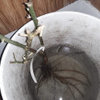plant-experts-say-thousands-of-roses-will-die
henry_kuska
10 years ago
Related Stories

WINTER GARDENINGPruning Secrets for Exquisite Roses
Encourage gorgeous blooms year after year with this time-tested advice on how to prune your rosebush in winter for health and shape
Full Story
TASTEMAKERSAsk an Expert: What Is the One Design Rule You Live By?
Eight home experts share their top design rules
Full Story
LANDSCAPE DESIGNCalifornia Says Goodbye to the Sprawling Ornamental Lawn
New state rules will effectively limit turfgrass to 25 percent of the landscape in most new and renovated yards
Full Story
KITCHEN DESIGNExpert Talk: 12 Ways to Get a Designer-Kitchen Look
Professional designer Ines Hanl reveals her thought processes on select kitchen remodels
Full Story
FARM YOUR YARDHow to Grow Vegetables in Containers
Get glorious vegetables and fruits on your patio with a pro’s guidance — including his personal recipe for potting mix
Full Story
HEALTHY HOMEHow to Childproof Your Home: Expert Advice
Safety strategies, Part 1: Get the lowdown from the pros on which areas of the home need locks, lids, gates and more
Full Story
SMALL HOMESAsk an Expert: What Is Your Ultimate Space-Saving Trick?
Houzz professionals share their secrets for getting more from any space, small or large
Full Story
KITCHEN DESIGNExpert Talk: Infuse Your Kitchen With Art
Concoct a showcase for your art on an often overlooked spot: the kitchen wall
Full Story
GARDENING GUIDESGreat Design Plant: Knock Out Roses
As glorious as their high-maintenance kin for a fraction of the work, Knock Out roses make even beginners look like garden stars
Full Story
DECORATING GUIDES12 Ways Your Home Can Say Happy Derby Day
Add a dash of fresh Kentucky Derby style to your home
Full Story








seil zone 6b MI
jim1961 / Central Pennsylvania / Zone 6
Related Professionals
Alexandria Landscape Contractors · Annandale Landscape Contractors · Apollo Beach Landscape Contractors · Brookfield Landscape Contractors · Hannibal Landscape Contractors · Hoffman Estates Landscape Contractors · Hollywood Landscape Contractors · Muttontown Landscape Contractors · Oxnard Landscape Contractors · Paso Robles Landscape Contractors · Rancho Santa Margarita Landscape Contractors · Rio Linda Landscape Contractors · Seymour Landscape Contractors · Vancouver Landscape Contractors · Reisterstown Landscape Contractorsdeervssteve
henry_kuskaOriginal Author
anntn6b
henry_kuskaOriginal Author
hoovb zone 9 sunset 23
anntn6b
henry_kuskaOriginal Author
henry_kuskaOriginal Author
kentucky_rose zone 6
anntn6b
kittymoonbeam
henry_kuskaOriginal Author
nastarana
anntn6b
henry_kuskaOriginal Author
dan_keil_cr Keil
windeaux
henry_kuskaOriginal Author
Maryl (Okla. Zone 7a)
henry_kuskaOriginal Author